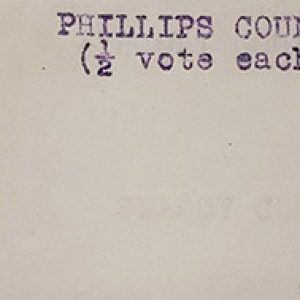calsfoundation@cals.org
Black and Tan Republicans
The Republican Party of Arkansas was formed in April 1867. Powell Clayton—a Union officer during the Civil War who moved to Arkansas to become a planter early in Reconstruction—became the key leader of the party. During Reconstruction, Republicans were elected to state offices at all levels—including governor. This Republican dominance ended, however, with the enfranchisement of former Confederate loyalists as Reconstruction ended in the state in 1874. Even after Reconstruction, the party remained visible, with newly enfranchised African Americans joining white Republican loyalists in biracial support of the party, with many Black men being elected to local office and the Arkansas General Assembly. In order to attract white Democrats, one faction within the Republican Party, known as the “Lily Whites,” sought the exclusion of African Americans from party ranks, while Black Republicans and their allies constituted the opposing “Black and Tans” faction.
In spite of the decline of the Republican Party as an effective force in state politics during the 1870s and 1880s, it retained its biracial character under the leadership of former governor Clayton, who relied upon a biracial majority to maintain his leadership. Black voting disenfranchisement in Arkansas induced by the Election Law of 1891, and the poll tax the next year, achieved limited results, with most middle-class African American men retaining their eligibility and traditional places in Republican governing councils. Black men made up roughly one-third of delegates at the state assemblies and remained staunch supporters of Clayton, who rewarded their loyalty during Reconstruction with certain federal service appointments in the state and secured their selection as state delegates to the party’s national convention.
Just as during Reconstruction, an anti-Clayton faction arose among Republicans who differed with him politically or failed to receive the patronage they aspired to. By 1888, a solid polarization of these two factions emerged: Clayton’s enduring biracial coalition, the “Black and Tans,” and those opposing racial inclusiveness, the “Lily Whites.” Interestingly, while they made no secret of their motives, the two factions rarely referred to themselves by their unofficial monikers applied by their critics and the media to distinguish them; they both considered themselves mainstream Republicans, with different agendas. One was attempting to conserve the party’s status quo as a biracial cooperative, and the other was acting to distance the party from this biracial image ostensibly to make it more competitive among the state’s dominant white voting public. This division proliferated in Republican parties across Southern states, even those in which Black Republicans far outnumbered white members. In Arkansas, the Black and Tans tended to reside in Delta counties and Little Rock (Pulaski County).
Powell’s Black and Tan protégé, Harmon L. Remmel, succeeded him as the state party’s central committee chairman in 1900. The transition left Black Republicans reliant upon Remmel to maintain a Black and Tan majority to counteract the Lily Whites’ aims to neutralize them. His action averted their seizure of power until 1914, when Lily Whites gained control of the state central committee. The victory marginalized the Black and Tans, whose numbers subsequently dwindled. Thereafter, Harmon declined to oppose with any vigor the Lily White leaders seeking to preserve his high stature in the party. Black and Tans responded to the Lily Whites’ tactics to bar their meaningful activity in the party by staging protests, infiltrating events, and even holding separate assemblies—with little effect.
Their most dramatic demonstration occurred at the party’s state convention in April 1920. Here, as in preceding years, the presiding Lily Whites mobilized immediately to reject Black and Tan delegations in Pulaski County. Consequently, Black and Tan delegates—fifty African Americans (including such influential figures as Scipio Africanus Jones) and about ten sympathetic whites—departed the venue and re-formed at the Mosaic Templars theater. They held a separate state Republican convention, where they formed their own platform “to overthrow lilywhitism…in this state,” nominating former slave turned education official Josiah H. Blount for governor. He received over eight percent of the vote in that year’s gubernatorial election.
In spite of this bold maneuver, African Americans’ former participation in the party never recovered. The racialized conflict inflicted irreparable damage to the party, and Black and Tans dissipated as political force. Ironically, however, the Lily White–dominated Republican Party performed worse than ever in state elections in 1922 and 1924.
For additional information:
Dillard, Tom W. “To the Back of the Elephant: Racial Conflict in the Arkansas Republican Party.” Arkansas Historical Quarterly 33 (Spring 1974): 3–15.
Gordon, Fon Louise. Caste & Class: The Black Experience in Arkansas, 1880–1920. Athens: University of Georgia Press, 1995.
Lewis, Todd E. “‘Caesars Are Too Many’: Harmon Liveright Remmel and the Republican Party of Arkansas.” Arkansas Historical Quarterly 56 (Spring 1997): 1–25.
Stockley, Grif. Ruled by Race: Black/White Relations in Arkansas from Slavery to the Present. Fayetteville: University of Arkansas Press, 2009.
Drew Ulrich
Division of Arkansas Heritage, Delta Cultural Center









Comments
No comments on this entry yet.